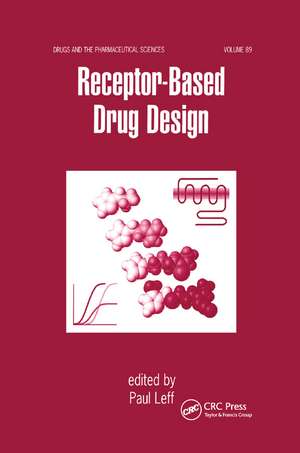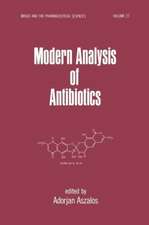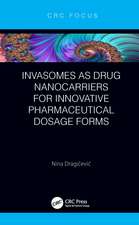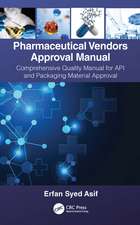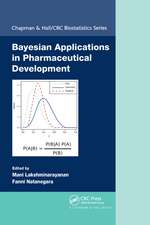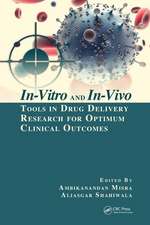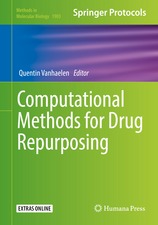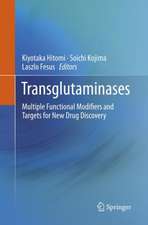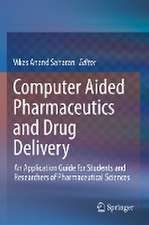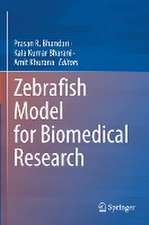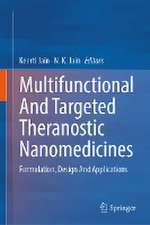Receptor - Based Drug Design
Editat de Paul Leffen Limba Engleză Paperback – 23 sep 2019
Explains the experimental and theoretical methods used to characterize interactions between ligands and receptors-providing the pharmacological information needed to solve treatment problems and facilitate the drug design process!
Demonstrating the achievements of the receptor-based approach in therapeutics and indicating future directions, Receptor-Based Drug Design
Written by over 25 international authorities and containing nearly 1200 bibliographic citations, Receptor-Based Drug Design is a practical resource for pharmacologists, pharmacists, and pharmaceutical scientists; organic and medicinal chemists and biochemists; molecular biologists; biomedical researchers; and upper-level undergraduate and graduate students in these disciplines.
| Toate formatele și edițiile | Preț | Express |
|---|---|---|
| Paperback (1) | 494.49 lei 6-8 săpt. | |
| CRC Press – 23 sep 2019 | 494.49 lei 6-8 săpt. | |
| Hardback (1) | 1233.99 lei 6-8 săpt. | |
| CRC Press – 10 apr 1998 | 1233.99 lei 6-8 săpt. |
Preț: 494.49 lei
Preț vechi: 581.75 lei
-15% Nou
Puncte Express: 742
Preț estimativ în valută:
94.65€ • 102.85$ • 79.56£
94.65€ • 102.85$ • 79.56£
Carte tipărită la comandă
Livrare economică 21 aprilie-05 mai
Preluare comenzi: 021 569.72.76
Specificații
ISBN-13: 9780367400521
ISBN-10: 0367400529
Pagini: 400
Dimensiuni: 152 x 229 x 25 mm
Greutate: 0.6 kg
Ediția:1
Editura: CRC Press
Colecția CRC Press
ISBN-10: 0367400529
Pagini: 400
Dimensiuni: 152 x 229 x 25 mm
Greutate: 0.6 kg
Ediția:1
Editura: CRC Press
Colecția CRC Press
Public țintă
Academic and Professional Practice & DevelopmentCuprins
Introduction, James Black
Principles and Measurement of Drug-Receptor Interactions
The Characterization and Classification of Receptors, Patrick P. A. Humphrey
Functional Methods for Quantifying Agonists and Antagonists, Iain G. Dougall
Quantification of Receptor Interactions Using Binding Methods, Sebastian Lazareno
Drug Analysis Based on Signaling Responses to G-Protein-Coupled Receptors, T. Kendall Harden, José L. Boyer, and Robert W. Dougherty
The Use of Electrophysiology to Improve Understanding of Drug-Receptor Interactions, John G. Connolly and Charles Kennedy
Receptor-Based Drugs in Medicine
Selective Adrenergic and Glucocorticoid Treatments for Asthma, David Jack
Serotonin 5-HT1B/D Receptor Agonists, Graeme R. Martin
Histamine H2-Receptor Antagonists, Michael E. Parsons
Angiotensin Antagonists, Mark J. Robertson
Experimental and Emerging Drugs
-Adrenoceptor Agonists and Antagonists, J. Paul Hieble and Robert R. Ruffolo, Jr.
P2U-Purinoceptor Agonists: Emerging Therapy for Pulmonary Diseases, Eduardo R. Lazarowski, William C. Watt, T. Kendall Harden, and Richard C. Boucher
Muscarinic Receptor Antagonists Pharmacological and Therapeutic Utility, Richard M. Eglen
NMDA Receptor Antagonists, John A. Kemp and James N. C. Kew
New Trends in Drug Design
Computational Chemistry in Receptor-Based Drug Design, Ad P. IJzerman, Eleonora M. van der Wenden, and Wilma Kuipers
Recombinant G-Protein-Coupled Receptors as Screening Tools for Drug Discovery, A. Donny Strosberg and Prabhavathi B. Fernandes
Inverse Agonists and G-Protein-Coupled Receptors, Richard A. Bond and Michel Bouvier
Principles and Measurement of Drug-Receptor Interactions
The Characterization and Classification of Receptors, Patrick P. A. Humphrey
Functional Methods for Quantifying Agonists and Antagonists, Iain G. Dougall
Quantification of Receptor Interactions Using Binding Methods, Sebastian Lazareno
Drug Analysis Based on Signaling Responses to G-Protein-Coupled Receptors, T. Kendall Harden, José L. Boyer, and Robert W. Dougherty
The Use of Electrophysiology to Improve Understanding of Drug-Receptor Interactions, John G. Connolly and Charles Kennedy
Receptor-Based Drugs in Medicine
Selective Adrenergic and Glucocorticoid Treatments for Asthma, David Jack
Serotonin 5-HT1B/D Receptor Agonists, Graeme R. Martin
Histamine H2-Receptor Antagonists, Michael E. Parsons
Angiotensin Antagonists, Mark J. Robertson
Experimental and Emerging Drugs
-Adrenoceptor Agonists and Antagonists, J. Paul Hieble and Robert R. Ruffolo, Jr.
P2U-Purinoceptor Agonists: Emerging Therapy for Pulmonary Diseases, Eduardo R. Lazarowski, William C. Watt, T. Kendall Harden, and Richard C. Boucher
Muscarinic Receptor Antagonists Pharmacological and Therapeutic Utility, Richard M. Eglen
NMDA Receptor Antagonists, John A. Kemp and James N. C. Kew
New Trends in Drug Design
Computational Chemistry in Receptor-Based Drug Design, Ad P. IJzerman, Eleonora M. van der Wenden, and Wilma Kuipers
Recombinant G-Protein-Coupled Receptors as Screening Tools for Drug Discovery, A. Donny Strosberg and Prabhavathi B. Fernandes
Inverse Agonists and G-Protein-Coupled Receptors, Richard A. Bond and Michel Bouvier
Descriere
Employing a wide range of examples from G-protein-coupled receptors and ligand-gated ion channels, this detailed, single-source reference illustrates the principles of pharmacological analysis and receptor classification that are the basis of rational drug design.
Explains the experimental and theoretical methods used to characterize interactions between ligands and receptors-providing the pharmacological information needed to solve treatment problems and facilitate the drug design process!
Demonstrating the achievements of the receptor-based approach in therapeutics and indicating future directions, Receptor-Based Drug Design
introduces novel computer-assisted strategies for the design of new agonists, antagonists, and inverse agonists for G-protein-coupled receptors
shows how to assess agonist concentration-effect curve data
discusses radioligand binding assays
presents new in vitro multiarray assays for G-protein-coupled receptors
explains the use of individual second messenger signaling responses in analyzing drug-receptor interactions
examines the role of electrophysiology in finding new drugs and drug targets
describes selectively acting b-adrenoceptor agonists and glucocorticoid steroids for asthma treatment
outlines the rationale for using angiotensin receptor antagonists
and more!
Written by over 25 international authorities and containing nearly 1200 bibliographic citations, Receptor-Based Drug Design is a practical resource for pharmacologists, pharmacists, and pharmaceutical scientists; organic and medicinal chemists and biochemists; molecular biologists; biomedical researchers; and upper-level undergraduate and graduate students in these disciplines.
Explains the experimental and theoretical methods used to characterize interactions between ligands and receptors-providing the pharmacological information needed to solve treatment problems and facilitate the drug design process!
Demonstrating the achievements of the receptor-based approach in therapeutics and indicating future directions, Receptor-Based Drug Design
Written by over 25 international authorities and containing nearly 1200 bibliographic citations, Receptor-Based Drug Design is a practical resource for pharmacologists, pharmacists, and pharmaceutical scientists; organic and medicinal chemists and biochemists; molecular biologists; biomedical researchers; and upper-level undergraduate and graduate students in these disciplines.
